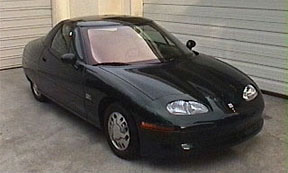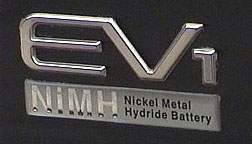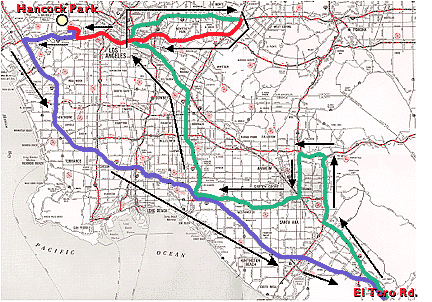

As one of the lucky "early adopters" of the first generation 1997 EV1, I was recently given the opportunity to live with one of the new 1999 "Generation II" EV1's equipped with a Nickel Metal Hydride battery pack. NiMH batteries have been a long time coming to the EV1 - their introduction has been delayed due to engineering and production issues. My test drives confirm that GMATV has nicely worked out most of the glitches and made the amazing EV1 into a car that's ready to make the world a better place for a much wider audience.

On Monday, January 18, 1999, I met GM's Chelsea Sexton at Saturn of Airport Marina in Los Angeles. After signing the necessary "vehicle loan agreement," I removed the charging paddle from the fully charged dark green 1999 EV1, VIN #77. The first improvement was quickly apparent: the charge port on the nose of the new EV1 now features a "detent" position. Many of us with the 1997 EV1's reported the inconvenience of the spring loaded charge port door that made inserting the paddle a bit of a hassle unless both hands are free. Thanks for listening to us, GM ! Now we'll have to develop the new habit of manually closing the door after removing the paddle. I've already forgotten to do that a couple of times in the past few days. A peek under the hood showed off the new inverter which is considerably smaller than the earlier unit - the drive motor was hidden under the larger '97 inverter, but is visible in the '99 model.

The second thing I noticed was that the doors close with less effort on the 1999 EV1. When the windows are fully up on my 1997 car, the doors sometimes need to be slammed closed, apparently because of inside cabin air pressure. The doors on the 1999 EV1 closed effortlessly every time with the windows up or down. I also noticed a new outside one piece roof-rail weatherstrip. Of course the big shocker was the "wake-up range:" 125 miles displayed on the range gauge when I booted the car. With the cooler weather we have during our mild southern California "winters," the wake-up range on a 1997 lead-acid battery EV1 is frequently 45 miles or even less depending on how the car was driven prior to being charged. I haven't seen over 101 miles on an EV1 range display since the "Charge Across America" cross country trip in my '97 EV1 in May 1998. Of course, that extraordinary range is rarely achievable by even the most skillful and conservative drivers of a Generation I EV1 - I enjoyed the advantages of a ideal road conditions and a warm battery pack when I saw 101 range in New Mexico last May.
Backing out of the parking space at Saturn of Airport Marina, I was a little disappointed to hear my old nemesis, the back-up warning klaxon. I can only surmise that the lawyers have convinced GM brass that big lawsuits are inevitable if an unwary pedestrian gets injured by a silent EV1. Rumor has it that it may be possible to disable the "beep-beep" on the '99s at the customer's request - many of us have voiced this little feature as our ONLY complaint about the car. Indeed, in my days with the '99 EV1, the back-up warning horn is the ONLY thing I wasn't ecstatic about. Another great improvement though: the heat pump for heat and a/c is MUCH QUIETER, even at full power. In fact, it's barely audible. Thanks again GM engineers! The cabin's a/c system seems to be more efficient, with more air volume at the registers. I haven't had a chance to test the heater. Another impression is more positive detents on the gear selector - my '97 is a bit sloppy, especially in the reverse position - I frequently need to maneuver the shift lever to engage the backup lights - not so on this '99, it snaps nicely into the gears.
The first thing I noticed on the open road is the big improvement in handling. Much less body roll on curves and a major improvement in typical front wheel drive torque steer. The '97s have a tendency to pull to the right when accelerating on a right turn, but this problem is virtually missing in the '99. This car handles like a sports car! A nice bonus is a less harsh ride than the earlier model. Congrats to Clive Roberts and his team for these major suspension improvements. Some '97 EV's have louder drive motors than others - my '97 is fairly quiet, so the noise level improvements in the redesigned '99 drive motor weren't very pronounced. I have driven other Gen I cars that are noisier than mine, so the quieter motor will be welcomed by many drivers. I could not detect any change in horsepower - you can still "burn rubber" with an NiMH-equipped EV1!
I drove 42 miles around town the first day without using even half the energy in the NiMH pack. I was "testing the performance" of the car, certainly not "babying" it. I decided to try a long distance run on the L.A. freeway system the first night, so I charged the car at home back up to 100%. Chelsea Sexton recommended that the battery pack be discharged below the half way mark before recharging, but it was 71% full when charging started - the car took 1 hour 25 minutes to fill to 100%, exactly the time reported by my charger at the beginning of the charge cycle. Throughout the charge and for 30 minutes or so after the charge completed, the battery pack "thermal conditioning" fans were audible. One issue with NiMH batteries is pack temperature - a warm NiMH pack won't accept a charge unless it is at or below a specified temperature - the engineers at GMATV obviously spent lots of their time over the last couple of years working on keeping the pack cool. The EV1's unique T-shaped pack configuration must have presented enormous cooling challenges.

No driver of a '97 EV1 would never dream of a drive like this in a lead-acid pack-equipped car. I drove 163.3 miles on one charge! Most of the drive was on fairly level terrain, the only notable exception was the hill on the 60 Freeway traveling west from the 605 freeway. I began the trip at 10:00 pm (outside temperature: 55 degrees) from my home in the Wilshire "Miracle Mile" district of Los Angeles, and drove I-10 west and I-405 as far south as El Toro Rd. near Laguna Hills. At the time I got off the freeway to turn around, I had traveled 65 miles and had only used 5 out of 11 bars on the charge indicator. The range indicator showed 98 miles remaining, for a total of 163 miles (this turned out to be a very accurate indication - I had driven 163.3 miles when I pulled into my garage with no charge bars remaining). When driving my '97 EV1 for maximum range, I keep a close eye on the "power use" gauge, trying to maintain 55-65 mph with no more than 5-6 bars of power use. Occasionally, 7 bars will be required for short distances to maintain safe freeway speeds. I adopted this same technique during this NiMH test run. When I connected my home MagneCharger at the end of this test run at 1:10 am, the charger reported "0% full - 5hrs 25min to fill." I woke up the next morning at 6:30 am, and indeed the charge was complete - only the battery pack fans were running with the charger displaying "full support."
My second day with the car was spent driving vigorously around the city. Two trips at "full blast" over the Cahuenga Pass and vigorous stop and go driving on city streets depleted the pack only 4 bars (out of 11 bars available) after 45 miles of driving. The home charger reported 65% full at the beginning of the charge cycle.
I noticed that the battery pack fans were operating much of the time while driving. The new rear fan was audible as a muted hum, not at all annoying. Inside the trunk, there is a slight hump at the forward end to accommodate the rear fan (the '97 trunk is virtually flat in this area). By the way, those of you with wanderlust like me have no fear - the non-portable 6.6kW charger fits in the trunk nicely in spite of the hump. (Of course, the 6.6kW charger is not designed or recommended for portable use).The convenience charger is absent, a casualty of the switch to NiMH. The owner's manual flatly states that "the convenience charger is not compatible with nickel metal hydride battery-equipped vehicles." I verified this by paddling my '97's convenience charger to the NiMH car as an experiment - the little charger's red "check" lamp came on, and no charging took place. No damage was done to the small charger during the experiment - it still works fine on the '97 (slowly, of course).
The third day was another endurance test and an interesting comparison with my red '97 EV1. My car was nearing the 25,000 mile mark and due for service (what little there is to do), so a friend and I hopped in both fully charged EV1's and headed down the Santa Ana Freeway to visit J.R. at Saturn of San Juan Capistrano, 65 miles from my home. It was a cool, rainy day - the outside temperature was 60 degrees, hardly ideal conditions to achieve maximum range in a lead-acid equipped electric car. Nearing Irvine with 15 miles to go, my '97 was showing 2 bars and 14 miles range remaining, with numerous ups and downs on the roadway ahead. The NiMH '99 had 8 bars remaining with 114 mile range remaining! We decided to charge the '97 up for 10 minutes at the Texaco Star Mart at Alton Parkway in Irvine. My '97 showed 18% full after inserting the paddle. We put the paddle in the '99 for a moment to find the NiMH pack 68% full after driving the same distance under the same conditions. This is an absolutely AMAZING IMPROVEMENT! Good thing I charged up the '97 a bit at the Texaco station, because we arrived at Saturn of San Juan with 1 mile range remaining. We left my '97 behind, and headed back home taking a more scenic route in the NiMH car. The Highway 73 Toll Road over the Laguna Hills has several big grades, and the rain was heavy at times - those factors along with the cool temperatures would take a heavy toll on a lead-acid electric car's range. After stopping in Westminster for lunch we drove home at maximum speeds. Total for the day's drive on one charge: 146 miles with 1 bar/5 miles range remaining.
It really dawned on me that an NiMH equipped EV1 takes the guesswork out of extended trips like these. The hassle factor that most of us with the early lead-acid cars have adjusted to is gone. Most drivers are simply not willing to do the math and deal with compromises in their driving style. With an NiMH EV1, I'm convinced that just about anyone can love this car. All the positive things we've come to appreciate with our '97s has always been slightly tempered by the range factor - these batteries change everything.
Days 4 and 5: Sorry GM , but I was very hard on your test car. I tried to get as little range as possible to simulate what kind of range someone living in the hills might expect. Lots of "performance demonstrations" and irresponsible use of the energy in the pack. After two days of brutality (without any intermediate overnight charging) the worst I could do was 86 miles on one charge.
Based on my experiences the last few days, I foresee typical driving ranges with an NiMH EV1 like this:
Of course, my little red '97 has become part of the family, and I can't imagine parting with it. I'm may add a second EV1 to my household. These advances are almost too tempting too pass up!
|
|
|
|
|
|